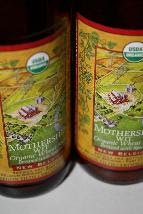On a recent trip to Vienna, Austria I was once again on the hunt for delicious beer and after a short bit of research, the solution became clear: Siebensternbräu Brauhaus, located one block from my hotel and a short distance from one of the many Christmas markets Vienna is famous for. As the cold winter months descend upon much of the northern hemisphere, I was especially excited to sample the winter seasonal release and I was in luck as they were currently pouring their Weihnachtsbock.
The place was abuzz with lunchtime crowds and upon arrival we were greeted by a large, open floorplan, and a seemingly very modern brewing facility; nevermind the massive copper brewing vessels visible at various locations near the bar. The walls were adorned with beer memorabilia; both posters and a massive framed collection of old coasters.
The menu features classic Austrian favourites including weinerschnitzel and schweinbraten. The menu also features, soups, pasta, sausages, a few vegetarian options, and traditional desserts. I opted for the schweinbraten and wasn't disappointed with the large portion of roasted pork, sauerkraut and massive potato dumpling.
Moving along to the beers, it is an important thing to note here that while German is the language spoken in Austria and it doesn't take long to cross the border into Germany, Austria was never subjected to the strict set of laws outlined in the Reinheitsgebot of 1516. If you're unfamiliar with this, it was in 1516 when German authorities ordered that all beers must be brewed with only three ingredients: water, hops, and barley (they later amended the law to include yeast when it was discovered to be the magical organism responsible for fermentation). The offerings at 7Stern include beers you won't often find in Germany, and I was more than pleased with this. I ordered what I believed to be a sampler flight and wound up with eight .2 L mini-steins (in the photo it looks like I have eight half-liter steins). Before arriving to 7Stern I had researched the beers and was disappointed to find out they'd just run out of their Chilli beer. I was however, able to sample the rest of their beers, which ranged from their lighter Wiener helles, Prager dunkel, pale ale, IPA, hemp beer, marzen, Bamberger rauchbier, and their dark winter bock.
The lighter offerings were on par with their styles and presented crisp, light-bodied-easy-to-drink beers. The hemp beer was interesting and reminded me much of an American pale ale; a little sweet and spicy with a noticeable hop kick. One of the stand outs for me was the IPA (which screamed English-style). Perhaps I was just hard up for a nice hoppy bitter brew (and my palate was off) but I really enjoyed this one. Normally the English-style IPA is well-balanced and the hops are subdued by a complementary malty sweetness, but this one tended to feature more of the hops than other English-style IPA's I've had (perhaps we can chalk this up as a hybrid English/American-style IPA); my inner hop-head was more than pleased with this fact. The next beer to jump out at me was the Bamberger rauchbier. Now I do consider myself well-versed in the world of smoked biers and I would love to try this one side-by-side with the famous Aecht Schlenkerla because in my opinion the Schlenkerla rauchbier is over the top smoky and nothing comes close, but this one from 7stern comes close. I was pleasantly surprised with this fact and highly recommend this beer if you're in the market for a super smoky rauchbier punch in the face. The last beer which really grabbed my attention was the winter seasonal: Weihnachtsbock. Colorwise it was by far the darkest of the offerings (as it should be) and I wasn't exactly sure what to expect. As German breweries traditionally release Doppelbocks during the winter months, I was expecting this beer to be similar in flavour. Typically they are high gravity, heavy-bodied, sticky malt bombs (not that this is a bad thing mind you) but my expectation was as such going into this. After the first few sips I was quite surprised to find that the beer was in fact lacking the higher-gravity of it's across-border German cousin: the Doppelbock. The beer was complex and featured a large amount of roasted malt flavour, something I had really been craving and been unable to satiate in the countries I'd travelled through prior to Austria. It reminded me of a slightly sweet porter and I really took my time to enjoy this one.
Should you find yourself in Vienna for the holiday's don't hesitate to stop in at Siebensternbräu Brauhaus, centrally located in the centre of the city, it makes for an excellent place to stop for a traditional Austrian lunch to fill up, warm up and take delicious drink; take your pick: light, dark, roasty, sweet, hoppy, or smoky, 7stern has you covered!
Thanks so much for reading and Happy Holidays from the Delicious Beer Blog!
Zach
.jpg)
.jpg)





.jpg)
.jpg)
.jpg)
.jpg)
.jpg)

.jpg)
.jpg)
.jpg)
.jpg)














.jpg)






.jpg)

.jpg)



+(size+edit).jpg)
.jpg)




